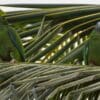Hispaniolan Amazon
Also known as:
Hispaniolan Parrot, Salle's Amazon or Parrot, Santo Domingo Amazon
Also known as:
Hispaniolan Parrot, Salle's Amazon or Parrot, Santo Domingo Amazon
DID YOU KNOW?
The incubation period for the eggs of the Hispaniolan Amazon is 27-29 days, longer than most parrots.

Amazona

ventralis
Size:
28 cm (11 in)
Weight:
250 g (8.75 oz)
Subspecies including nominate:
one
Colour Adult:
Both adults in general green, with black edges to feathers of head, breast and underparts; white forehead and lores; dull blue crown and upper cheeks, black edging on feathers; black ear coverts; spot on chin red; lower abdomen has maroon patch which varies in size from bird to bird; green tail with red at base. Beak horn-coloured. Eye ring white. Eye dark brown.
Colour Juvenile:
As in adults but blue on crown minimal or absent; white forehead often washed with yellow; patch on abdomen minimal or absent. Upper mandible has grey at base.
Call:
Calls are described as loud, continuous screeching while in flight; often a soft chatter or growl while at rest or feeding. Males at the beginning of breeding season produce melodic chattering sounds.
More Information:
Content Sources:
CITES
BirdLife International
Cornell Lab of Ornithology/Birds of the World
Parrots: A Guide to Parrots of the World, Juniper and Parr, 1998
Parrots: Status Survey and Conservation Plan 2000-2004, Snyder, McGowan, Gilardi, Grajal, 2000.
Parrots of the World, Forshaw and Cooper, 1977. 2010 edition
Parrots of the World, Forshaw, 2006.
Lexicon of Parrots, Thomas Arndt.
Parrots in Aviculture, Low, 1992.
Psittacine Aviculture, Schubot, Clubb and Clubb, 1992.
Captive Status:
Uncommon
Longevity:
50+ yrs
Housing:
Aviary or suspended enclosure, metal construction, minimum length 3 m (9.8 ft).
Diet:
Fruit such as: apple, pear, orange, banana, cactus fruits, pomegranate, forming about 30 percent of the diet; vegetables such as: carrot, celery, green beans and peas in the pod; green leaves such as: Swiss chard, lettuce, sowthistle, dandelion, chickweed; spray millet; small seed mix such as: millet, canary, and smaller amounts of oats, buckwheat, safflower, and a little hemp; soaked and sprouted sunflower seed; cooked beans or pulses, and complete kibble.
Enrichment:
Extremely vigorous chewer so provide bird-safe, unsprayed flowering, fir, pine or willow branches and perches, heat sterlized pine cones, wood and vegetable tanned leather toys, foraging/puzzle toys, swings, ropes and ladders. Also provide overhead misters or shallow bowls of water for bathing.
Nest Box Size:
Vertical box 10″ x 10″ x 24″ (25.4 cm x 25.4 cm x 61 cm).
Clutch Size:
3-4
Fledging Age:
9 weeks
Hatch Weight:
—
Peak Weight:
—
Weaning Weight:
—
World Population:
6000-15,000 mature individuals, rapidly decreasing.
IUCN Red List Status:
Vulnerable
CITES Listing:
Appendix II
Threat Summary:
A BirdLife ‘restricted range’ species. Is declining rapidly due to agriculture, charcoal production, persecution and trapping for the wild bird trade. Populations may, however, be exhibiting tentative increases in urban refuges such as Santo Domingo, but further research is needed to verify this.
Range:
Hispaniola (Haiti and Dominican Republic), including Grande Cayemite, Gonave, Saona and Beata Islands, Greater Antilles, West Indies. Introduced to St. Croix and St. Thomas in the Virgin Islands, and Puerto Rico.
Habitat:
Found up to 1500 m (4920 ft) in various habitats including from arid lowland palm savannas to upland pine forest and humid mountain forest.
Wild Diet:
Feeds on seeds and fruits of palms, cacti, Caesalpinia and Psidium guava. Cultivated fruits also taken.
Ecology and Behaviour:
Seen in pairs while breeding, at other times in small groups of up to a dozen birds. Within the flock pairs and families are clearly identified from the rest of the group. Extremely territorial when breeding.
Clutch and Egg Size:
3-4 eggs, 35.5 x 27.5 mm (1.4 x 1.1 in).
Breeding Season:
February-May; nest is in tree cavity.
Related Links:
—
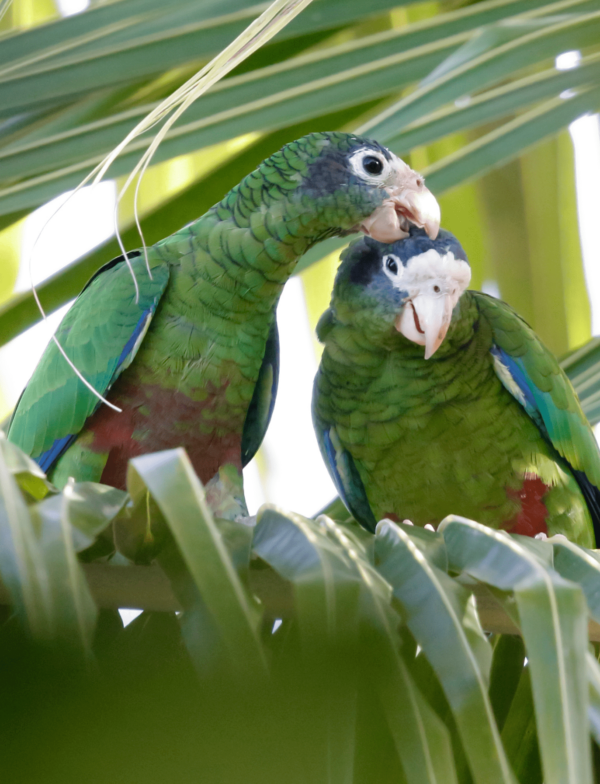

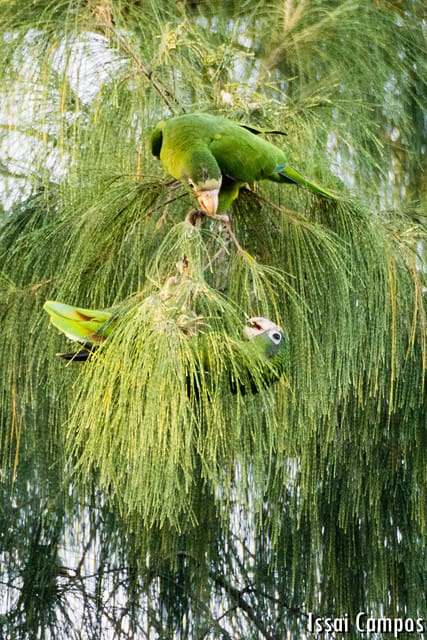
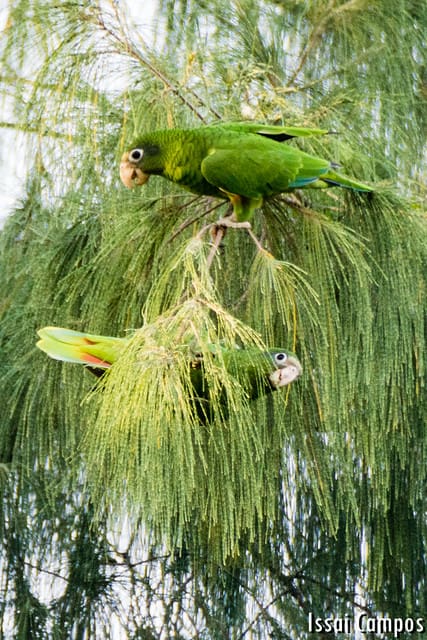
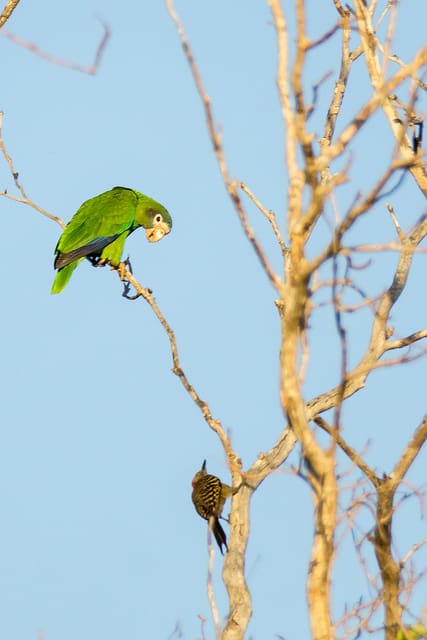
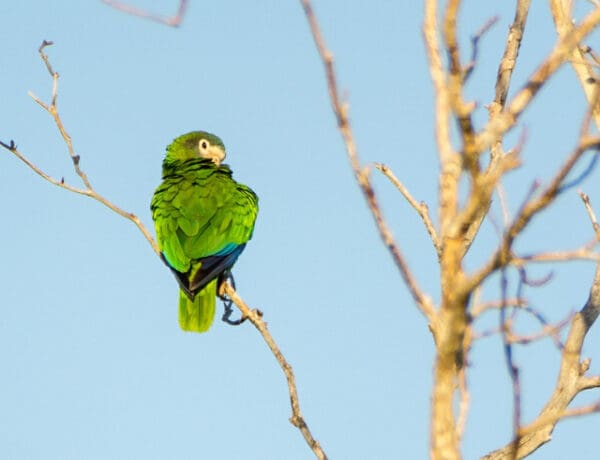
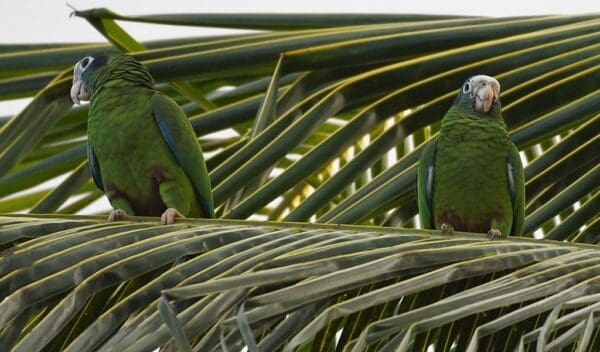

![© Issai Campos [CC BY-NC-ND 2.0] via Flickr A wild Hispaniolan Amazon perches atop a tree](https://parrots.org/wp-content/uploads/2023/01/wpt_Hispaniolan-Amazon_1411-11-100x100.jpg)
![© Issai Campos [CC BY-NC-ND 2.0] via Flickr Wild Hispaniolan Amazons play in a tree](https://parrots.org/wp-content/uploads/2023/01/wpt_Hispaniolan-Amazon_1411-10-100x100.jpg)
![© Issai Campos [CC BY-NC-ND 2.0] via Flickr Wild Hispaniolan Amazons play in a tree](https://parrots.org/wp-content/uploads/2023/01/wpt_Hispaniolan-Amazon_1411-9-100x100.jpg)
![© Issai Campos [CC BY-NC-ND 2.0] via Flickr A wild Hispaniolan Amazon peers at a small bird](https://parrots.org/wp-content/uploads/2023/01/wpt_Hispaniolan-Amazon_1411-8-100x100.jpg)
![© Issai Campos [CC BY-NC-ND 2.0] via Flickr A wild Hispaniolan Amazon preens itself](https://parrots.org/wp-content/uploads/2023/01/wpt_Hispaniolan-Amazon_1411-7-100x100.jpg)
